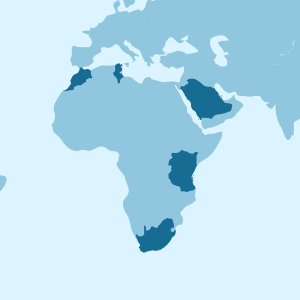Taxes in Luxembourg vs Spain: Which should I pay?
Here’s the comparison you’ve been looking for between taxes in Luxembourg vs. Spain. Discover the tax rates in both countries!
The taxes in Luxembourg vs. Spain have significant differences that you should know if you’re planning to reside in either of these countries. The rates vary due to each government’s fiscal policy, both at the national and local level. Depending on your personal situation and whether you’re an individual or a business, you’ll have to pay a higher or lower amount.
Both countries will open their doors to you as a resident, student, worker, investor, or tourist. However, they will require you to comply with your tax obligations to help the government collect funds to ensure quality services for citizens.
It’s also important to know the tax benefits each system offers, so we’ve analyzed the taxes in both countries and bring you a comparison in this blog post. Don’t miss out on this valuable information to help you choose your residence in the country that offers the most advantages, which will be reflected in your savings and economy. Want to know which country is the most suitable for you? Let’s discover it!

Taxes for businesses or legal entities
Businesses or legal entities, when conducting business in a country and earning profits, are obligated to declare these earnings to the state. For this purpose, each country sets taxes, both direct and indirect, with rates governed by various factors: Location, sector, assets, etc. Therefore, taxes in Luxembourg vs. Spain can have significant differences in their rates, as they are two European countries with different tax systems. Let’s analyze the main taxes:
1. Corporate Tax in Luxembourg vs. Spain
This type of tax is personal, direct, and applies to the profit earned by companies based in a given country, similar to income tax for individuals. The tax period is usually 12 months and must be filed even if no income was earned during that year. Let’s see the differences between both countries:
- Luxembourg: Has a general rate of 23.87%, which includes corporate tax, solidarity surcharge, and the municipal tax on activities. This country offers tax reductions for the first years of operation.
- Spain: Has a general rate of 20%, and for companies operating in the banking or hydrocarbons sector, it can reach 30%. There are reductions for the first two years of startup activity with a rate of 15%.
2. VAT in Luxembourg vs. Spain: What’s the Difference?
Luxembourg has a competitive tax system with lower rates than other European countries. Specifically, we can see this reflected in VAT (Value Added Tax), an indirect tax on consumption derived from the purchase of goods or professional services. Businesses must include this tax on their invoices and remit it periodically to the tax system. Let’s see how this tax is applied in each country:
| VAT Type | Luxembourg (rate) | Examples in Luxembourg | Spain (rate) | Examples in Spain |
|---|---|---|---|---|
| General | 17% | Electronics, clothing, cars. | 21% | Electronics, clothing, cars. |
| Reduced | 8% | Processed food, medicine. | 10% | Processed food, medicine. |
| Super Reduced | 3% | Basic foods, printed books. | 4% | Basic foods, medicine. |
| Special Rate | 14% | Fuel, catering services. | Not available | Not available |
VAT Rates in Luxembourg vs. Spain.
3. Taxes on Dividends and Capital Gains
When a company earns profits and distributes them among its shareholders, these shareholders must declare the amount received in their income, whether in cash, new shares, or subscription rights. Depending on how these dividends are received, they will be taxed differently. As we’ve seen so far, taxes in Luxembourg vs. Spain also differ in their rates:
- Luxembourg: Taxes dividends distributed to shareholders at a rate of 15%.
- Spain: Has a rate ranging from 19% to 26%, depending on the amount received.
Important: If you are a frequent traveler and want to stay connected without worrying about expensive roaming or looking for a new SIM at every destination, Holafly’s subscription plans are for you. With a single eSIM, enjoy internet in more than 160 countries for a fixed price and no surprises on your bill. Travel without limits and connect easily and securely! 🚀🌍

4. Local taxes
Finally, another type of tax that businesses face are local taxes: Business licenses, property, activity, etc. In general, Luxembourg has higher rates for businesses, while Spain has more variation in range, as each autonomous community imposes its own rates. Generally speaking, we can see the characteristics of these local taxes in the table below:
| Local Tax Type | Luxembourg (rate) | Example | Spain (rate) | Example |
|---|---|---|---|---|
| Municipal Tax on Activities | 6% – 10.5% (depending on location) | €100,000.00 = €6,000.00–10,500.00 ($6,600.00–11,550.00) | 0.4% – 1.3% of cadastral value | €200,000.00 = €800.00–2,600.00 ($870.00–2,830.00) |
| Property Taxes | 0.7% – 1% of property value | €500,000.00 = €3,500.00–5,000.00 ($3,810.00–5,440.00) | 0.3% – 0.9% of cadastral value | €500,000.00 = €1,500.00–4,500.00 ($1,630.00–4,890.00) |
| License Fees | Variable depending on activity | €500.00–2,000.00 ($540.00–2,180.00) | Variable depending on activity | Similar costs. |
Characteristics of local taxes in Luxembourg vs. Spain.

Taxes for individuals or natural persons
1. VAT in Luxembourg vs. Spain Spain
As we saw earlier with businesses, VAT is also an indirect tax applied to individuals, as it is charged on the products they purchase or services they hire. In Luxembourg, the general rate is 17%, the lowest in the European Union, while in Spain, it is 21%. Both countries apply reduced rates for essential products, let’s review these rates:
- General rate: Luxembourg 17% and Spain 21%. For example, a clothing item priced at €50.00 ($53.00), in Luxembourg, the final price will be €58.50 ($61.50), while in Spain, it will cost €60.50 ($63.50).
- Reduced rate: Luxembourg 8% and Spain 8%. A €5.00 ($5.25) medicine will have the same final price of €5.40 ($5.65) in both countries.
- Super-reduced rate: Luxembourg 3% and Spain 4%. A loaf of bread priced at 1 euro (€1.05) in Luxembourg will cost three cents more, and four cents more in Spain.
- Special Rate: Only Luxembourg offers a 14% rate for fuel.
2. Luxembourg vs. Spain, Where to Pay Less Personal Income Tax?
Income tax is levied on the earnings of citizens and residents in each country. In Luxembourg, this tax has a progressive structure that ranges from 0% to 42%, depending on the income level. In Spain, the rate is also progressive but can go up to 47% in some autonomous communities. Here are some popular examples to give you an idea:
| Income Level | Luxembourg (rate) | Example | Spain (average rate) | Example |
|---|---|---|---|---|
| €20,000.00 ($21,000.00) | 8% | Tax of €1,600.00 ($1,760.00) | 12% | Tax of €2,400.00 ($2,640.00) |
| €50,000.00 ($52,500.00) | 20% | Tax of €10,000.00 ($11,000.00) | 22% | Tax of €11,000.00 ($12,100.00) |
| €100,000.00 ($105,000.00) | 39% | Tax of €39,000.00 ($42,900.00) | 43% | Tax of €43,000.00 ($47,300.00) |
Income tax characteristics in Luxembourg vs. Spain.
3. Taxes on Wealth: Luxembourg vs. Spain Differences
Wealth tax is about declaring the assets and rights that each individual owns, excluding debts and financial obligations. In Luxembourg, there is no such tax, which is an advantage for people with significant wealth.
However, Spain applies this progressive tax based on the value of wealth, which can reach up to 3.5%. The rate for this tax is determined by autonomous communities. For example, for an estate worth €500,000.00 ($544,000.00), the tax in Spain would amount to €1,000.00 ($1,090.00) per year, whereas in Luxembourg this tax obligation does not exist.
4. Inheritance and Donation Taxes
When an individual receives an inheritance or donation, they must pay the inheritance or donation tax. The rates depend on the degree of kinship between the person transferring the assets and the recipient, as well as the total value of the assets. Want to know the rates of these taxes in Luxembourg vs. Spain?
- Luxembourg: Rates are very low and only apply to direct inheritances, i.e., between parents and children or spouses. The rates range from 0% to 10%. For example, if you receive an inheritance valued at €500,000.00 ($544,000.00), you would pay approximately 2%, which is €10,000.00 ($10,900.00).
- Spain: This tax is higher, as rates vary between 7% and 34%, depending on the value of the assets, the autonomous community, and the kinship. Some autonomous communities, such as Madrid, offer exemptions for direct inheritances, while others, like Andalusia, have higher rates.
For example, in a Spanish community with an average rate, a person receiving an inheritance worth €500,000.00 ($544,000.00) from a parent would pay a 10% tax, amounting to €50,000.00 ($54,400.00). Since the degree of kinship changes the percentage, if the beneficiary is a nephew, the rate could rise to 25%, resulting in €125,000.00 ($136,000.00).

Luxembourg vs. Spain Tax Comparison
So far, we’ve reviewed each type of tax between both countries, for both businesses and individuals. We’ve been able to observe the advantages and disadvantages of each country and where it’s more beneficial to reside with significant wealth, open a business, or buy a home. We’ve helped you gain a more detailed view of the tax landscape between Luxembourg vs. Spain with these two tables summarising the information discussed in the previous sections.
1. Tax Table for Luxembourg and Spain for Businesses
| Tax | Luxembourg Rate | Spain Rate |
|---|---|---|
| Corporate Tax | 24.94% | 25% |
| VAT | 3% – 17% | 4% – 21% |
| Wealth Tax | 0% | 3.5% |
| Inheritance and Gift Tax | 0% – 10% (direct inheritances) | 7% – 34% (depending on kinship) |
| Property Tax | 0.7% – 1% (cadastral value) | 0.3% – 0.9% (cadastral value) |
| License Fees | Variable depending on activity | Variable depending on activity |
Business tax summary in Luxembourg vs. Spain.
2. Tax Table for Luxembourg and Spain for Individuals
| Tax | Luxembourg Rate | Spain Rate |
|---|---|---|
| Income Tax | 0% – 42% | 19% – 47% |
| VAT | 3% – 17% | 4% – 21% |
| Dividend Tax | 15% | 19% – 26% |
| Municipal Tax on Activities | 6% – 10.5% (depending on location) | 0.4% – 1.3% (cadastral value) |
Individual tax summary in Luxembourg vs. Spain.
In conclusion, taxes in Spain are higher, especially for products you buy through VAT, and receiving an inheritance or donation represents one of the highest tax rates in all of Europe. On the other hand, the Spanish tax system offers a progressive structure that benefits lower or middle incomes. If you’re a foreigner residing in Spain and need guidance on where to keep your finances, here’s our post on the best banks in Spain for foreigners.
In Luxembourg, this country has more favourable tax rates, especially for VAT and corporate taxes. It’s a destination that benefits higher incomes and wealthier individuals, as the government does not apply wealth tax. Additionally, receiving an inheritance or donation with such low rates makes it a beneficial process for the recipient. If you’d like to dive deeper into Luxembourg’s taxes, here’s a link to our article: Taxes in Luxembourg: What are they and how much do I have to pay?














































 Pay
Pay  Language
Language  Currency
Currency 


















 No results found
No results found









